
Mission Ranch is a historic hotel and restaurant in Carmel, Monterey County, California, United States. It is located in the unincorporated Mission Tract south of the incorporated city of Carmel-by-the-Sea, near the Carmel Mission, at 26270 Dolores Street. The property was bought in 1986 by Clint Eastwood, who restored the premises in the style of the original buildings. The hotel has 31 rooms located within ten buildings on the property.

James Franklin Devendorf, was a pioneer real estate developer and philanthropist. Devendorf and attorney Frank Hubbard Powers (1864-1921), founded the Carmel Development Company in 1902. He became the "Father" of an artists and writers' colony that became Carmel-by-the-Sea, California, which included the Carmel Highlands, California. Devendorf spent the next 30 years of his life developing Carmel and the Carmel Highlands into a community of painters, writers, and musicians.

Perry Harmon Newberry was an American writer, actor, and director. He was a past editor and publisher of the Carmel Pine Cone and the fifth mayor of Carmel-by-the-Sea, California. Newberry is best known for his efforts to "keep Carmel free from tourists." At his death the Pine Cone said he was "Perry Newberry...Creator of Carmel." He lived in Carmel for 28 years.
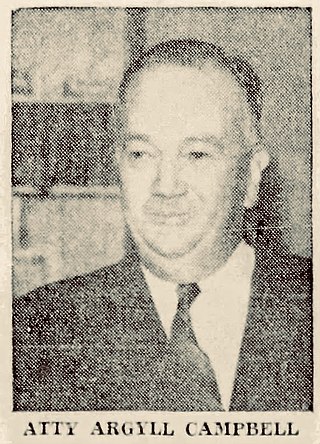
Argyll Campbell was city attorney for Carmel-by-the-Sea, California from 1920 to 1937. He was former chairman of the California Democratic Party to elect governor Culbert Olson. Campbell was a leader in Monterey Peninsula civic life for twenty-eight years. He was known for his efforts to "keep Carmel from radical change."

The Monterey County Trust & Savings Building, also known as China Art Center, is a historic Spanish Mission Revival commercial building in Carmel-by-the-Sea, California. It was designed by architects H. H. Winner Co., of San Francisco and built in 1929–1930, by Hugh W. Comstock and Michael J. Murphy. It was designated as an important commercial building in the city's Downtown Historic District Property Survey on October 18, 2002.
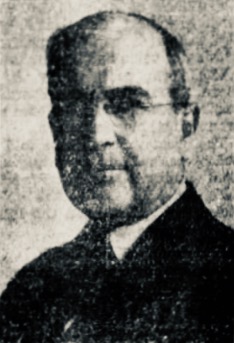
Ray Congdon De Yoe, also known as Ray C. De Yoe served in the California State Assembly for the 48th district from 1929 to 1931. He was president of the Carmel Realty Company and had real estate holdings in Monterey County, California, including the De Yoe Building in Carmel built by Michael J. Murphy.
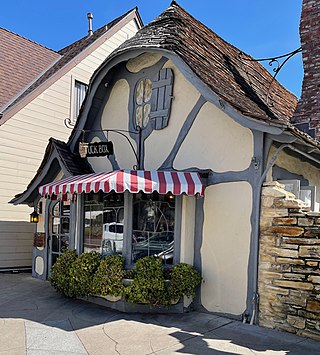
The Tuck Box is a historic Craftsman Storybook style commercial building in downtown Carmel-by-the-Sea, California, United States. It was built in 1926, by master builder Hugh W. Comstock. The building was designated as a significant commercial building in the city's Downtown Historic District Property Survey, and was recorded with the Department of Parks and Recreation on October 8, 2002.

The Garden Shop Addition is a historic Craftsman commercial building in downtown Carmel-by-the-Sea, California. The kiosk was designed and built in 1931, by master builder Hugh W. Comstock, and is adjacent to The Tuck Box and the Lemos Building. The shop was designated as a significant commercial building in the city's Downtown Historic District Property Survey, and was recorded with the Department of Parks and Recreation on October 8, 2002. The building is occupied by Exclusive Realty.
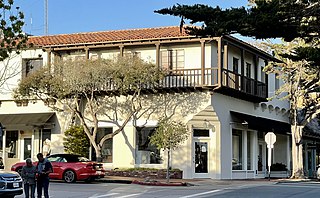
The Goold Building is a historic two-story concrete commercial building in downtown Carmel-by-the-Sea, California. The building is an example of Spanish Colonial Revival and Monterey Colonial styles. The building qualified as an important commercial building in the city's downtown historic district property survey and was registered with the California Register of Historical Resources on February 3, 2003.
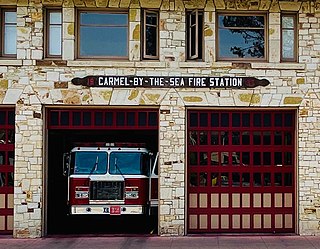
The Carmel Fire Station, also known as Station No. 15, is a historic two-story fire station in downtown Carmel-by-the-Sea, California. The firehouse is an example of Modern Civic and WPA style architecture. The fire station qualified as an important building in the city's downtown historic district property survey and was registered with the California Register of Historical Resources on April 25, 2002. The Carmel fire station is still in operation.

The Wilson Building, also known as the Philip Wilson Building is a historic commercial building in downtown Carmel-by-the-Sea, California. It is an example of American Craftsman architectural style that was built in 1905 on the corner of Ocean Avenue and Dolores Street as a real estate office. In 1916 it became Carmel’s first official City Hall. The building qualified as an important building in the city's downtown historic district property survey and was recorded with the California Register of Historical Resources on November 30, 2002.
The following is a timeline of the history of Carmel-by-the-Sea, California, United States.

George Washington Reamer , was an early American pioneer, mining engineer, and building contractor, who in 1908 built one of the earliest homes on Reamer's Point, known today as Carmel Point, just outside the city limits of Carmel-by-the-Sea, California.

Charles Olin Goold, was a pioneer businessman, landholder, civic leader, and well known banker. He ran the first livery yard in Carmel-by-the-Sea, California, in 1907. He owned the Goold Building, which was once called the Hotel Carmel in the early 1910s. He was elected city trustee and Street commissioners of Carmel and was on the board of directors and vice-president of the Bank of Carmel.

Hatton Fields is an unincorporated community southeast of downtown Carmel-by-the-Sea in Monterey County, California, United States. Homes have views of Carmel Valley, Point Lobos, and Carmel Bay. The residential neighborhood is bordered by Rio Road to the south, Hatton Road to the north, Hatton Canyon to the east, and Junipero Street to the west. The terrain is rolling and naturally landscaped with mature oaks, redwoods, and Monterey Pine trees. Carmel High School, Carmel Mission, and Flanders Mansion are landmarks in this neighborhood. Carmel Mission and Flanders Mansion are two properties that are listed on the National Register of Historic Places. The Mission Trail Nature Preserve runs adjacent to Hatton Fields. Homes are part of the Carmel Unified School District.

James Cooper Doud was an American businessman and real estate developer in Carmel-by-the-Sea, California. He established the Doud Building in 1932, built by master builder Michael J. Murphy. He also owned The Doud Arcade, a two-story commercial building built in 1961 that connects with The Doud Craft Studios.
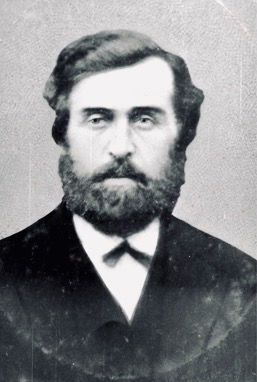
John Martin, was an early pioneer from Scotland who arrived to Monterey County, California in 1856. He purchased 216 unsettled acres (87 ha) near the mouth of Carmel Valley, close to today's Carmel Mission, predating the development of Carmel-by-the-Sea. Martin built a farmhouse on the property in the early 1870s for his wife and children near Carmel Point, known today as Mission Ranch, owned by Clint Eastwood since 1986.
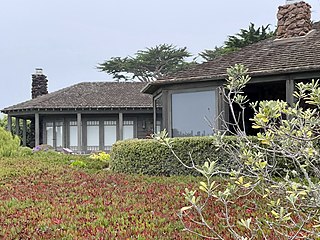
Driftwood Cottage, often simply called Driftwood, is a historic home located on Carmel Point at the southern city limits of Carmel-by-the-Sea, California. It has views of Carmel Bay, Carmel River, and Point Lobos. It was the first house built on Carmel Point and became the home of actress Jean Arthur. Architect George W. Reamer built the house in 1908 for Florence E. Wells.

















